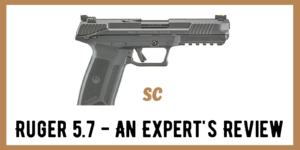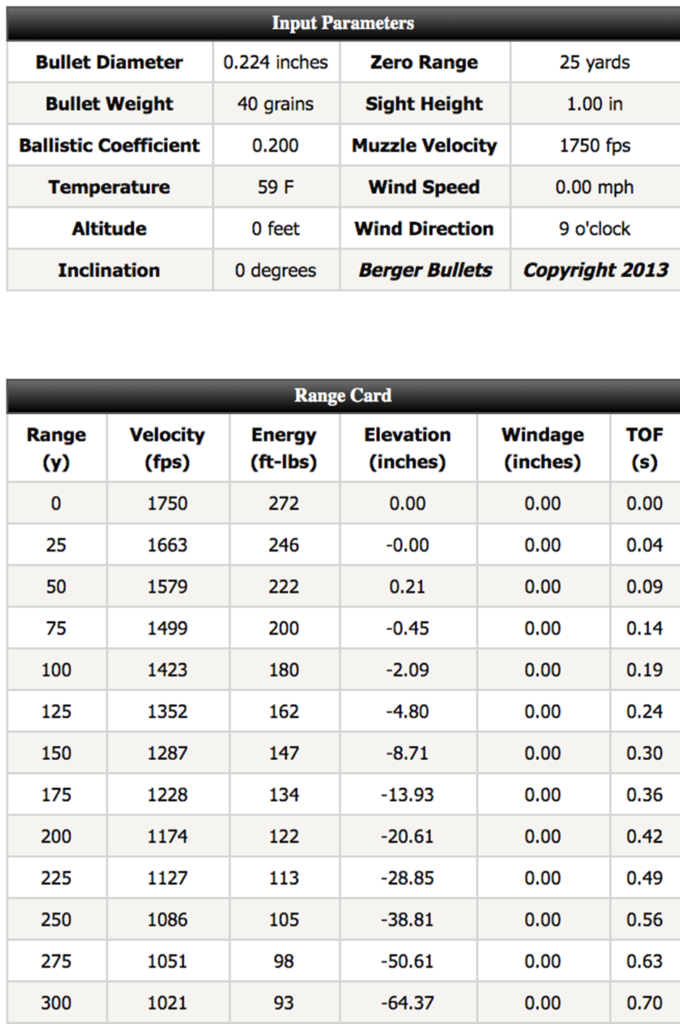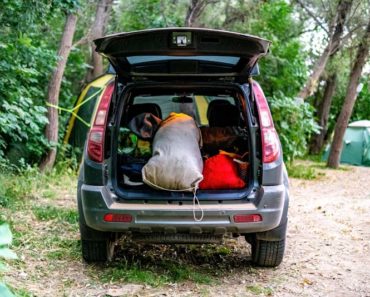Sturm Ruger is a well-known and highly respected gun maker. Ruger’s #1 rifles are some of the most sought-after firearms in the world. The pistols built by Ruger are just as popular. Now, Ruger has entered the market with the Ruger 5.7 and it is rapidly becoming a major player in the 5.7 shooting world.
FN Herstal developed the 5.7×28 cartridge along with the FN P90 PDW and the FN Five-Seven pistol as a replacement for the 9x19mm Parabellum cartridge in use by NATO forces in Europe. The 5.7 cartridge continues to grow in popularity with military and law enforcement groups around the world.
Sturm Ruger entered the 5.7 markets in 2019 with the Ruger 5.7 pistol. The Ruger 5.7 has the stylings of a traditional semi-automatic pistol. The 5.7 cartridges and the Ruger 5.7 pistol have some interesting characteristics that any shooter should understand. To fully appreciate what Ruger has accomplished with the Ruger 5.7 pistol, let’s take an in-depth look at this pistol.
Understanding the 5.7 Cartridge
Central to anything about the Ruger 5.7 pistol is an understanding of the 5.7×28 cartridge that it shoots. FN Herstal developed the 5.7 cartridges from scratch. There is no parent cartridge from which this round was derived. The development of the cartridge was spurred by a NATO request for a cartridge to replace the 9×19 Parabellum cartridge currently in use by NATO forces.
The NATO Requirements
NATO set out specific requirements for a new combat handgun cartridge. At this time, anticipating the NATO request, FN Herstal had been developing the 5.7 for several years. NATO wanted a cartridge with more range, better accuracy, and improved terminal performance. NATO also included a requirement that any new rounds be able to penetrate body armor.
After testing by NATO, along with several other new cartridges from other manufacturers, the NATO test team recommended that the 5.7×28 cartridge be adopted. Ballistic comparisons, environmental testing, and combat shooting tests proved the 5.7×28 to be a superior cartridge. At present, more than 40 countries use the 5.7x 28 cartridges for their military and law enforcement handguns.
5.7×28 Ballistics
The 5.7 cartridge delivers impressive ballistic performance by almost any standard you choose. There are now many different types of 5.7 ammunition available from a variety of manufacturers. Many of the ammunition types are restricted to military or law enforcement organizations. The most prevalent loading available for civilian use is the AE5728A cartridge that fires a 40 grain projectile.
Most of this ammunition develops 2,500 feet per second velocity at the muzzle delivering 445 foot-pounds of energy. These are typically full metal jacketed bullets with an effective range of about 660 feet. Compare these numbers with a 9mm Parabellum cartridge. The 9mm fires a 115 gr bullet delivering a muzzle velocity of 1145 feet per second and energy of 335 foot-pounds. The effective range of the 9mm Parabellum is usually listed at about 100 yards.
5.7×28 Characteristics
Overall, the 5.7×29 cartridge offers other advantages beyond better ballistics. The cartridge is lighter, allowing personnel to carry more cartridges for the same load weight than the 9mm Parabellum. One advantage cited by NATO testers was the size of the cartridge that allows manufacturers of the 5.56×45 NATO rifle cartridge to easily manufacture the 5.7×28 cartridge on existing equipment using the same tools.
The Ruger 5.7
Ruger came at the design for its 5.7 entry into the market with the usual Sturm Ruger basic fundamentals. From the very beginning of the company, Sturm Ruger has held to its belief that the company should depend on expertise, service, uniqueness, simplicity, and strength of design. I might add that Ruger has always made value a great part of their concept.
The Ruger 5.7 hold to these traditions especially when you consider simplicity and strength of design. The Ruger 5.7 is a departure from many other pistols chambered for the 5.7×28 cartridge which gives it a unique advantage in some ways.
The Overall Impression
When I first handled the Ruger 5.7, I was impressed with the overall look and feel of the pistol. Ruger has a reputation for tight quality control and impressive engineering. Just looking at the Ruger 5.7, it is apparent that Ruger has put a lot of thought and care into the design and construction of these pistols.
I have never been particularly impressed with the design of many other 5.7 pistols. However, Ruger’s entry into this market gives me a different impression. Many other 5.7 pistols have a different look. Ruger chose to create a traditionally styled semi-automatic pistol. If you put a Ruger 5.7 next to almost any other semi-automatic pistol, they look much the same.
Ruger’s designers have done a good job of creating a new pistol that feels like it fits. This pistol is what would be considered a duty size. However, it is not awkward or clumsy to handle and is relatively lightweight. All in all, this is a pistol that looks good, feels good, and shoots good.
Ruger 5.7 – Features
Ruger has loaded the 5.7 with a bag of features that should make any shooter happy. Sturm Ruger understands shooters and shooting and their products always focus on building reliable firearms, functional firearms, and accurate firearms. I found the Ruger 5.7 to be outstanding in all these areas.
Ergonomics
One statement I hear often from pistol shooters about new guns or guns different from their regular choice of firearms is, “it just doesn’t feel right.” How a gun “feels” in your hand is a function of the rake or angle on the grip, the size and shape of the grip, and the balance of the pistol as you hold it.
Weight and Balance
Ruger definitely scores high on the weight and balance meter. When I picked up the Ruger 5.7 for the first time, I was amazed. This is a pistol with a relatively long barrel length and I was afraid that it would be front-heavy.
The center of gravity for this pistol is a bit forward, indicating to me that the long barrel does make the gun a bit front-heavy. However, the more I handled and shot this gun, the less I noticed this difference. Since my normal carry firearm is a Glock 43 it doesn’t surprise me that I noticed the difference in the front weight.
Grips
Factory grips are almost always something that gets lower marks on a new pistol. Many times I find factory grips to be slick, small, or just uncomfortable. To my surprise, the factory grips on the Ruger 5.7 are better than I expected. The factory grips are lightly stippled but not abrasive. There is a certain amount of what I call stickiness. When you grip the pistol, it doesn’t want to slip around in your hand.
The grip size can be an issue for some people. If you have smaller than average hands, the grips on the Ruger 5.7 may be a tad large. Really big shooters with wide hands often find the grips a little small. For me, the fit is almost perfect.
Front and Rear Sights
To me, the sights on a pistol are much like eggplant. You either love it or hate it, and there isn’t much in-between space. Front and rear sights on pistols are probably one of the most changed pieces of equipment. Personally, I like the Glock three-dot system. It is simple and effective.
Ruger has taken a different tack with the sights on the 5.7. The pistol comes from the factory with a green fiber optic front sight. I have never used a fiber optic front sight on a pistol. I was surprised at how easy it was to pick the fiber optic front sight out and get it on target.
The rear sight is a basic bladed sight with dots. For me, the biggest problem with the dots on the rear sight was finding them and the green dot on the front sight. The green dot of the fiber optic seemed to wash out the rear dots.
The rear sight is fully adjustable for elevation and windage. A slotted screw on top of the sight lets you easily adjust the sight up or down depending on your needs. I have never worried too much about adjusting sights on a pistol. I worry more about grouping shots which has more to do with technique and consistency than setting the sights.
Operating Controls
Ruger has stuck with the basic standard set of pistol controls for the 5.7. It has a mag release, a slide release/catch, and a takedown lever. Pretty much what you would expect from any modern semi-automatic pistol
- The Magazine release is one area that I would ask Ruger to improve. To me, the magazine release seems small. A larger button or more pronounced feel would make dropping an empty mag easier for me. The magazine release is smooth and mags drop-free without a problem. If you intend to carry the Ruger 5.7 as a personal defense weapon, mag changes are important and a consideration you should make.
- I found the slide lock stiff and a little difficult to operate out of the box, However, this really isn’t an issue since I rarely use the slide lock. I do appreciate that the slide locks back when the magazine is empty. If you practice mag changes you will appreciate this feature. I would have liked to see an ambidextrous slide lock lever.
- The takedown lever is located in the middle of the gun in front of the slide lock lever. Not much to say about this. It works as it should and doesn’t interfere with my grip or holstering the firearm.
Trigger
The trigger on the Ruger 5.7 follows Glock’s lead. The pistol has a factory bladed safety trigger that should engage when you squeeze the trigger to move the internal action fire control system out of the safe position. In theory, when you want to fire, you just have to squeeze the trigger to take the gun off safe. Theory is great. When it works.
I tend to put my finger in the middle of the trigger blade or near the top of the trigger. I found that at times, the trigger safety would not release. To get the secure action fire control system to disengage required me to get my trigger finger down on the end of the trigger. This can be rather disconcerting on the range. In a life or death situation, it could be a disaster.
The trigger pull seems just a tad long and there is no indication of separation in the two stages of the trigger. All in all, Ruger missed the mark with this trigger design in my book.
The Practical Details
For me, the practical details are about the design, construction, and materials used in the manufacture of the gun. In a shooting world dominated by polymer-frame pistols, Ruger has followed the industry trend. Don’t take me wrong. I have nothing against polymer-framed semi-automatic pistols. I routinely carry a Glock 43. However, I know there are some purists who think a gun is made of metal, not plastic.
The Slide
Ruger stuck with conventional wisdom on the slide. The hardened billet steel slide is functional and efficient. Strategic cuts and grooves milled in the hardened steel lighten the slide. The lightening cuts mean less mass on top of the gun means less weight to carry. This lightened slide also helps reduce felt recoil as the gun operates. The slide is drilled and tapped at the factory for an optional optics adapter plate if you choose to add a red dot to your pistol.
The Barrel
The standard barrel length is 4.94 inches. Each Ruger 5.7 comes with an alloy steel barrel with a nitride treatment for wear resistance. Ruger offers for sale an alloy steel barrel as a threaded replacement barrel. The barrel threading is standard 1/2×28 and includes a wrench and a thread cover. The threaded barrel does increase barrel length. However, if you are adding a suppressor, this additional barrel length is not a problem. The threaded alloy steel barrel is also nitride treated.
Note: The Ruger 57 threaded barrel option is subject to local laws. Be sure to check your local laws before ordering.
Magazines
Each Ruger 5.7 comes from the factory with two steel magazines. The factory magazines work precisely with the mag release and the slide lock when the magazine is empty. Ammunition feeds smoothly from these magazines making them reliable. I have not tested the Ruger 5.7 with polymer magazines or the most popular after market mags.
Picatinny Rail
Forward of the trigger guard, the frame of the Ruger 5.7 has a length of Picatinny rail for mounting accessories. The most common accessory mounted on semi-automatic pistols is a good light. I mounted a TLR-1 pistol light on the rail. I did find that the long trigger guard put the controls on the flashlight just out of reach of my finger.
Inspection Port
Rather than using a loaded chamber indicator like some handguns, Ruger choose to include an inspection port on the firearm. The inspection port allows you to easily determine the state of your pistol without having to partially pull back the slide.
Models and Availability
Ruger manufactures severe different models of the 5.7. Some of the models, like the TALO variations are available only from specific dealers. Ruger also offers a state-compliant model that comes with a 10-round magazine in states where applicable laws limit magazine capacity.
Ruger also offers the 5.7 in a Pro model but, for the life of me, I can’t figure out what the differences are between these standard and pro models. Maybe one of our readers can enlighten me on what makes the pro model different.
A look at the internet reveals that the Ruger 5.7 remains in good supply. I wouldn’t count on this being the case much longer. As interest in the 5.7 grows among shooters. Several discount retailers have these firearms ready for purchase as well as ammo to get you on the range.
Firing the Ruger 5.7
I’ll be the first to admit that firing the Ruger 5.7 is just plain fun to shoot. The gun is reliable and operates smoothly. The recoil is surprisingly less than I expected. In fact, I judge it to have less recoil than my 9mm pistols. This makes the Ruger 5.7 a good choice for smaller shooters and those with less hand and forearm strength. These folks should be able to shoot the Ruger 5.7 without much problem.
I did not experience a single failure to fire or jam during my range time. The magazine release worked perfectly and the magazines dropped free immediately. I was not as impressed with the trigger pull as I had hoped to be. The secure action fire control system still needs a bit of work I am afraid. I hope Ruger is reading this and taking my recommendations to heart.
My Take on the Ruger 5.7
If you want a fun gun to shoot, I highly recommend the Ruger 5.7. This gun offers reliability and functionality, and it is a visually appealing weapon. The trigger needs some work by Ruger, but it is functional once you learn the idiosyncrasies of finger placement. The only other downside I have is the cost of 5.7 ammunition. The fact that you can purchase a Ruger 5.7 for considerably less than the other 5.7 guns on the market is an additional bonus.






































